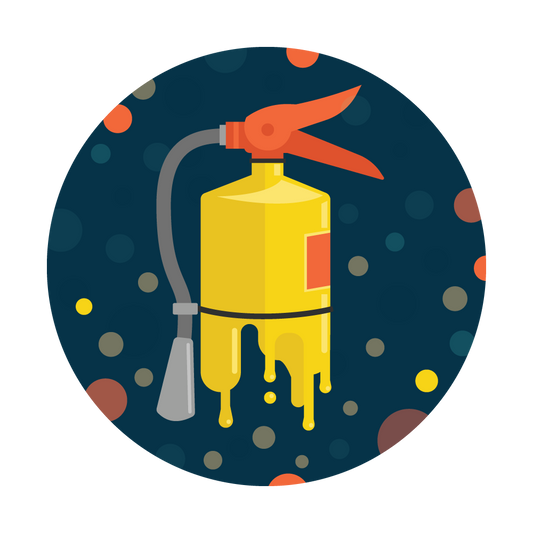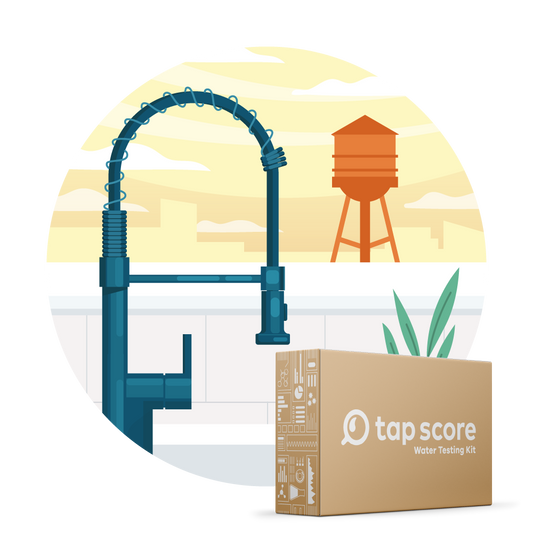
What Is the Best Way to Test for PFAS in Drinking Water?
Our blog is written by real experts— not AI. Each guide is carefully reviewed and updated based on the latest research. Plus, with no affiliate links, you can count on unbiased insights you can trust.
PFAS water testing is crucial for proactive homeowners because per- and polyfluoroalkyl substances (PFAS) are highly prevalent and have been linked to various health risks. In this guide, we’ll take you step by step through the PFAS water testing process, from home to lab and back.
For a more in-depth breakdown of all things pertaining to “forever chemicals,” read the Ultimate Guide to PFAS.
Table of Contents:
- How to Test for PFAS in Water
- Why Testing PFAS in a Laboratory Is Important
- How Are PFAS Tested in a Laboratory?
- What Do I Need To Know About Collecting a PFAS Sample?
- What's the Takeaway?
How to Test for PFAS in Water
The best—and only—way to test for PFAS in your home’s drinking water is through a certified laboratory. PFAS water testing kits are increasingly available, but you can also reach out to your local health department, water utility, or environmental protection agency to learn if they have kits or specific testing options available.
Tap Score’s PFAS water testing collection has a variety of mail-to-lab test kits to analyze your drinking water for PFAS with the latest EPA testing methods.
What Are the EPA’s Testing Methods for PFAS?
The EPA has developed, validated, and published four methods to support the analysis of 29 PFAS in drinking water:
- Method 533
- Method 537
- Method 537.1
- Method 8327
They have been through a rigorous multi-lab validation process and peer reviewed.
For more detailed information on the relationship between EPA’s testing methods and unregulated contaminants (which PFAS technically are until their proposed regulations are implemented under the Safe Drinking Water Act), please see our references below.[1]
Do DIY Test Strips Work for PFAS?
Test strips do not have the capability to accurately detect the presence of PFAS in a sample of water. Due to their properties, PFAS require specialized equipment to determine whether or not their levels are unsafe.
Why Is Testing PFAS in a Laboratory Important?
Testing for PFAS in water requires highly sophisticated tools and expertise only found in a laboratory setting. That’s why testing is typically conducted by environmental testing laboratories and/or in conjunction with government agencies.
But even though PFAS analysis itself takes place in laboratories, you'll be collecting the sample of your home’s drinking water to send out for testing. Often, PFAS water testing kits (either from an agency, lab or kit provider) come with detailed instructions—some even include free shipping to the laboratory.
How Do I Find a Lab that Can Test My Drinking Water for PFAS?
The Environmental Protection Agency (EPA) put together a list of approved labs accredited for testing PFAS according to EPA methods.[2] You can either order a PFAS water testing kit directly from the lab, or through kit providers (like Tap Score) who work with a network of labs to help streamline the process.
Recommended Labs:
- Pace Analytical
- Enthalpy Analytical
- Eurofins Scientific Services
A note on environmental laboratory accreditation: In order to foster environmental laboratory data of known and documented quality in a cost-effective manner, the EPA founded NELAC (the National Environmental Laboratory Accreditation Conference) to help develop nationally recognized accreditation standards.[3]
How Are PFAS Tested in a Laboratory?
PFAS testing involves an analytical chemistry technique called liquid chromatography with tandem mass spectrometry (LC-MS/MS). LC-MS/MS is highly sensitive and can be used to measure certain compounds (like PFAS) down to very low levels. Precise working methods to test for PFAS using this technique have been developed by the EPA.
PFAS testing demands a high level of analytical sensitivity to ensure accuracy. For example, the EPA’s initial health advisory for PFAS (70 PPT) was more than 100 times lower than the Maximum Contaminant Levels for more common water contaminants like arsenic (10000 PPT) and nitrate (1000000 PPT).
PFAS Testing Methods

EPA Method 537
Developed in 2008, EPA’s Method 537 tests exclusively for long-chain, legacy PFAS (like PFOA and PFOS) up to a total of 14 compounds.
EPA Method 537.1
Revised in 2018, EPA’s Method 537.1 added 4 more PFAS to its repertoire, including HFPO-DA (more commonly known as “GenX”), for a total of 18.
Tap Score’s standard PFAS Test Kit tests for 14 PFAS in accordance with both EPA Method 537 and its 2018 revision, Method 537.1. It is our most popular PFAS test.
EPA Method 533
Published in 2019, the EPA developed Method 533 to complement Method 537.1 with a particular focus on short-chain PFAS (including GenX). Method 533 alone tests for 25 PFAS. Combined with 537.1, the methods can test for up to 29 PFAS.[4]
Tap Score Recommends: GenX and PFAS Water Test for 25 PFAS in accordance with EPA Method 533; EPA 533 is ideal for performing PFAS testing that reflects the latest EPA regulatory discourse.
EPA Draft Method 1633
Still undergoing lab and peer review, EPA’s Draft Method 1633 opens testing capabilities up to 40 PFAS compounds in surface water, groundwater, wastewater, soil, biosolids and more.[5] The fourth draft of this method is under development.
Test your drinking water for 40x PFAS compounds by the most current and comprehensive method available.
EPA 1633 PFAS Water Test
Sale price
£794.00 GBP
Tap Score’s 1633 PFAS Water Test utilizes the draft method to test for 40 PFAS compounds in a water sample.
EPA Method 8327
Validated in 2021, EPA’s Method 8327 is a broad screen test for 24 PFAS compounds. It is less sensitive than 537.1, 533, or 1633. By introducing a slightly less accurate screening option, PFAS screening becomes more accessible.
What Is the Difference Between Long-chain and Short-chain PFAS?
How Do I Know Which Method Is Right for Me?
Choosing the right testing method is a balance between budget and needs.
The most affordable PFAS water test kits use methods that test for the fewest PFAS compounds (Methods 537 and 8327). If you are looking to learn more about PFAS in your water but your budget is tighter, these could be the right fit.
On the other hand, if you live in an area known to be at risk for widespread PFAS contamination (for example, near an airport, military base, chemical or manufacturing plant), you might want to invest in a more thorough test (Methods 533 or 1633). A recent USGS study found that the most populous areas (cities and suburbs) where heavy industry has or once had a large presence are the most contaminated.
Reaching out to your health department or environmental agency, or taking a look at public water data, like through Tap Score’s City Water Project, can help you decide what’s most pressing in your area.
Why Is Testing for PFAS So Expensive?
Put simply, testing for PFAS in water relies on specialized equipment and highly trained personnel. The cost of utilizing such expertise is reflected in the increased cost of the testing kits. Research into the thousands of PFAS compounds is ongoing.
What Do I Need to Know About Collecting a PFAS Sample?
Collecting a sample of water for PFAS testing requires more care and caution than most water testing samples. The prevalence of PFAS in our homes and environment can lead to contamination of the sample if adequate precautions are not taken. Most testing kits will come with precise instructions on how to collect your sample(s).
The process itself, however, is as simple as mailing your sample to a lab and getting your results sent back. Always follow the instructions provided exactly.
Collecting Samples
Follow the specific guidelines provided by the laboratory or kit provider to collect water samples properly. Ensure that the samples are free from any contamination to get accurate results.
If you are testing your water for PFAS at home, we have developed the following guidelines to best collect your sample:
Avoid wearing these materials:
- Clothing or shoes containing Gore-Tex, Tyvek, or other waterproof synthetics (often advertised as waterproof, water repellant, or dirt/stain resistant)
- Clothing recently dry cleaned or washed with fabric softeners
- Cosmetics, moisturizers, perfume, anti-perspirant, deodorant, insect repellent, and sunscreen (unless they explicitly say they're PFAS-free)
Keep away from your sample:
- Felt-tip pens and permanent markers
- Anything sticky like Post-it notes and glues
- Plastics (as much as possible)
- Aluminum foil
Take extra precautions to:
- Avoid fast food, pre-wrapped food or snacks, carry-out food, or other food items right before or during sampling
- Wash your hands before collecting the sample(s)
- Only use sampling containers that have been provided by your laboratory service provider
Tip: Keep your samples cool while also being mindful of time of day and outside temperature.
Mailing Samples
Package the collected samples according to the instructions provided by the testing laboratory and send them out for analysis. The laboratory will then conduct the necessary tests to detect PFAS in the samples.
Tip: Consider shipping your samples as soon as possible after collection. If you need to wait, keep your samples refrigerated, but do not wait longer than 24 hours.
-
-
-
Is Shipping Included in the Price of a Test?
Not always. When purchasing a test kit, look for those that include a prepaid shipping label to get your samples to the laboratory. Not every company includes this.
-
What Is the Turnaround Time on PFAS Testing?
Depending on the lab and/or provider, PFAS analysis has a turnaround time of 10-15 days. It can take a bit longer to receive results.
-
Is Shipping Included in the Price of a Test?
-
Reviewing Results
Once the analysis is complete, the laboratory will provide you with a comprehensive report detailing the presence and concentration of PFAS in your drinking water.
-
Public Water Supplies
If concerning levels of PFAS are detected in your tap water, reach out to your local utility to see if they’re taking any steps toward PFAS mitigation, and consider a treatment device for your home.
-
Private Well Supplies
As a private well owner, PFAS mitigation is your responsibility, from testing to treatment. You can reach out to your local health department to see if they have information on PFAS in your area, but testing your well water is the key first step.
-
What Unit of Measurement Do the Results Come In?
Units will depend on the lab or kit provider, although every report will specify what unit of measurement is being used. Common units include: PPM, PPB, PPT, mg/L, µg/L, ng/L
-
What Is the Acceptable Limit for PFAS in Drinking Water?
In April 2024, the EPA announced maximum contaminant levels (MCLs) of 4 PPT for PFOA and PFOS, 10 PPT for PFNA, PFHxS, and HFPO-DA (GenX). PFBS, PFNA, PFHxS, and Gen X will also be regulated together as a group using a unitless hazard index. These values are grounded in the health-based MCLGs (of 0—meaning that they conclude that there is no safe level of these compounds in drinking water) but also incorporate cost and feasibility of treatment.
Depending on how high your PFAS levels are, you might want to consider seeking an alternative water source until you can address the situation.
How Do I Remove PFAS from My Drinking Water?
Quick Guide to Certified Water Filters for PFAS
Note: Many reports directly from a laboratory can be quite difficult to interpret. Tap Score features easy-to-read reports along with clear health impacts and treatment suggestions.
What’s the Takeaway?
- Laboratory test kits are how to test your water for PFAS. Whether you’re purchasing them from a provider or receiving one from a public utility or health department, you will be collecting a sample of your water for analysis. Test strips cannot test for PFAS.
- Collecting samples for PFAS analysis requires maximum attention due to the relative prevalence of PFAS in every household environment. Make sure to wash your hands before collecting the sample and use only sampling containers that have been provided by your laboratory service provider.
- The EPA has announced MCLs of 4 PPT for PFOS and PFOA; 10 PPT for PFNA, PFHxS, and HFPO-DA (GenX). If your test comes back with PFAS levels exceeding recommended health thresholds, you might want to consider an alternative source while you look into treatment options. Reach out to your local utility for advice if PFAS is a known issue in your region.
Read More
▾Sources and References
▾- EPA PFAS Drinking Water Laboratory Methods | US EPA
- Laboratories Approved by EPA to Support UCMR 5 (March 2023)
- National Environmental Laboratory Accreditation Program (NELAP) | Science Inventory | US EPA
- EPA Analytical Methods for PFAS in Drinking Water
-
CWA Analytical Methods for Per- and Polyfluorinated Alkyl Substances (PFAS) | US EPA
- EPA Response to Public Comments on SW-846 Update VII, Phase 2 – Method 8327









